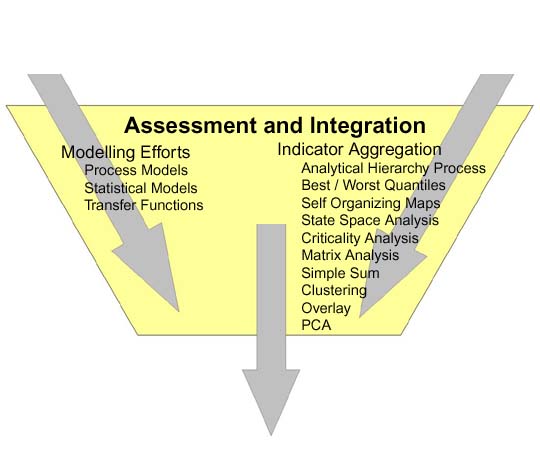ReVA Overview
Basic Information

More Information
- ReVA Overview
Presentation (PDF) 25 pp., 17.8MB, About PDF
An ecosystem is the living and non-living components of an environment within which most or all nutrients are recycled. The interactions among the living (i.e., biotic) and non-living (i.e., abiotic) factors within an ecosystem determine the ecosystem’s functionality.
An understanding of the dynamics of an ecosystem and the factors that influence its connectivity to the landscape is essential for informed environmental management and conservation of biodiversity. Conservation and land managers currently are not armed with reliable approaches for managing ecosystems. ReVA's data-gathering and research products are likely to underpin conservation and management decisions made in the future.
ReVA's approach to understanding vulnerability is analogous to human health in that there many factors that contribute to problems in complex ways. The word vulnerable in this context means open to attack or damage. Thus, vulnerability can be the degree to which a system is likely to experience harm as a result of exposure to perturbations or stress.
In terms of human health, a doctor monitors patients by using indicators such as blood pressure, blood tests, genetic screening, or other examinations. Taking into account factors such as family history, obesity, diet, and smoking, a doctor can identify likely risk factors that can impact an individuals life span or quality of life. While precise predictive models linking common indicators to health problems don’t normally exist, carefully designed studies across large populations can determine the probability or likelihood of you developing particular health conditions. In terms of ecosystem indicators such as degraded stream water quality and polluted air are indicators that can be used as evidence of vulnerability within environmental systems.
Regional vulnerability of ecosystems can be assessed by understanding sensitivities to particular stressors that may have inherent properties that predispose an organism or an ecological system to problems. Stressors can be identified by studying places in which similar organisms or systems were affected by those same stressors in the past. Based on this information, we can determine the likelihood of future problems, even if we can't precisely predict the exact conditions that will occur in any specific location.
The application of ReVA's methodology is generally to answer the following assessment questions:
The diagram below summarizes the vulnerability assessment process used by the ReVA program.
- What is the overall condition of the region?
- What is the relative environmental condition given all variables or a subset (e.g. those related to water quality)?
- What and where are the current, most pressing environmental risks for a region?
- What and where is the greatest risk in the future?
- Where are the strategic planning or restoration priorities for a region?

![[logo] US EPA](../gif/logo_epaseal.gif)